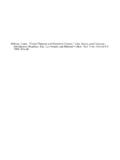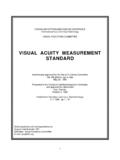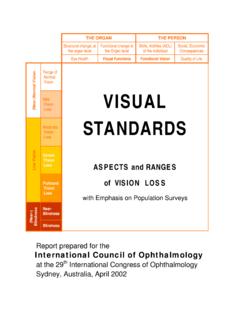Transcription of DEFINITION : VISUAL IMPAIRMENT - - :: Blind …
1 CHAPTER IDEFINITION : VISUAL IMPAIRMENT (Expert comments: Ms. Karin van Dijk)New Vision Consultant1. DefinitionIn India, the broad DEFINITION of VISUAL IMPAIRMENT as adoptedin the Persons with Disabilities (Equal Opportunities, Protectionof Rights and Full Participation) Act, 1995 as well as underthe National Programme for Control of Blindness (NPCB) isgiven : refers to a condition where a person suffersfrom any of the following conditions, namely:lTotal absence of sight; orlVisual acuity not exceeding 6/60 or 20/200 (Snellen)in the better eye even with correction lenses; orlLimitation of the field of vision subtending anangle of 20 degree or deciding the blindness, the VISUAL acuity as well as fieldof vision have been Low Vision: The Persons with Disabilities Act, 1995 alsorecognizes low vision as a category of disability and definesit as follows: Person with low vision means a person withimpairment of VISUAL functioning even aftertreatment or standard refractive1correction but who uses or is potentially capableof using vision for the planning or execution ofa task with appropriate assistive device.
2 This DEFINITION is incomplete as it inadvertently omits quantificationof the acuity as well as the field of vision as is done in thecase of the WHO DEFINITION . It is desirable to modify thisdefinition and the following quantification should be added: Low vision are those who suffer VISUAL acuitybetween 20/200 to 70/200 (Snellen) or 6/18 to6/60 in the better eye after the best possiblecorrection or a Field of Vision between 20 to 30degrees .The WHO working DEFINITION of Low Vision (WHO, 1992) isas follows: A person with low vision is one who has impairmentof VISUAL functioning even after treatment, and/or standard refractive correction, and has a visualacuity of less than 6/18 to light perception or avisual field of less than 10 degrees from the pointof fixation, but who uses, or is potentially ableto use, vision for the planning and/or executionof a task.
3 The points emphasized are that there is significantly reducedvision, VISUAL performance is affected but that there still isvision that can be used. This last point is very important: ifthere is usable vision, training to use that vision might bepossible. In addition, this person is not labelled of VISUAL impairmentCate- Corrected WHO DefinitionIndiangory VA-betterStandard*Working#Definitioneye0 6/6-6/18 NormalNormalNormal1<6/18-6/60 VisualLow VisionLow VisionImpairment2<6/60-3/60 Severe VisualLow VisionBlindImpairment3<3/60-1/60 BlindLow VisionBlind4<1/60-PLBlindLow VisionBlind5 NPLB lindTotalTotalBlindnessBlindnessThe standard WHO DEFINITION is used in medical reports andpublications and is solely based on VISUAL acuity and doesnot take into account functional vision.
4 #The WHO working DEFINITION has been adopted since WHOC onsultation in 1992. This working DEFINITION is solely usedfor reporting purposes and should not be used for eligibilityof importance of the functional DEFINITION lies in the label people are given. Someone with a VISUAL acuity of 2/60 canhave useful vision, for example, for mobility. However, he orshe will be labelled Blind person. The consequence is this person23is than treated as if he/she is a Blind . This ignores the usablevision. There should be a difference between legal blindnessand functional blindness or low WHO standard DEFINITION defines blindness as VISUAL acuityof less than 3/60 in the better eye with the best possible correctionas compared to that of 6/60 in India. The WHO functionaldefinition, however, considers blindness starting at light perceptionor when a person has no usable vision.
5 Similarly, a personwith VISUAL acuity better than 3/60 but equal or less than 6/60is graded as Blind in India, while WHO grades him as India a person with a VA < 6/60 is legally Blind , whichenables to receive certain services and financial benefits. However,a person who is legally Blind can still have useful vision to docertain tasks, as can be seen in the working DEFINITION . Thisrefers to the fact that they still have functional vision, whichis the use of vision for a particular India or other developing countries, it is essential to maintainthe legal DEFINITION of blindness at the level of VISUAL acuityof 6/60 (20/200 Snellen) or less and field of vision of 20 degreeor less. Already the travel concessions, scholarship and otherbenefits are very meagre, if perception of light to no perceptionof light is considered blindness, a large of persons who areat present availing these concessions would fall outside theeligibility criteria and thus remain bereft of these , if these concessions are extended to all the personswith low vision in the acuity range of 6/18 to perception oflight as defined by WHO, the appropriate Government maynot be able to meet the demand due to financial India and other developing countries, it is desirable tomaintain the DEFINITION of blindness as adopted in the Personswith Disability Act, 1995, VISUAL acuity of 6/60 (20/200)
6 Or less and field of vision of 20 degree and less and to considerall the persons in the range of acuity of 6/18 to 6/60 (20/60to 20/200) as persons with low the recommended DEFINITION for low vision in Indian contextshould be Low vision are those who suffer VISUAL acuity between20/200 to 70/200 (Snellen) or 6/18 to 6/60 in the better eyeafter the best possible correction. One-Eyed Person: There is a controversy regarding theinclusion of one-eyed persons in the category of DEFINITION of blindness adopted in India exclude peoplewith IMPAIRMENT only in one eye from the purview of in medical parlance, disability is synonymous to the physicalimpairment and the level of such IMPAIRMENT has been prescribedfor certifying a person to be disabled. Generally, the impairmentof 40 percent or more is considered a handicap.
7 As percentageof IMPAIRMENT in the case of a one-eyed person is only 30percent, according to the approved DEFINITION in medical parlance,a person with one good eye is not a Blind person. In short, aperson with VISUAL IMPAIRMENT of 40 per cent or more is considereda Blind Committee of the Ministry of Social Justice and Emplowermenton Recommendation of Standard DEFINITION of Disabilityrecommended that one eye-eyed persons should be excludedfrom the other categories of VISUAL IMPAIRMENT so that facilitiesand concessions available to severely and profoundly visuallyimpaired persons are not eroded. The committee, however, feltthat loss of one eye would not be considered as a disqualificationon medical grounds unless a particular post is of such a technicalnature that it requires of a person to have the coordinated useof both eyes or three dimensional Persons with DeafblindnessDeafblindness is a condition presenting other difficulties thanthose caused by deafness and blindness.
8 It is an umbrella term which can include children and adults who may sufferfrom varying degrees of VISUAL and hearing IMPAIRMENT , perhapscombined with learning difficulties and physical disabilities,which can cause:l severe communicationl developmental, andl educational includes children and adults who are:l Blind and profoundly deafl Blind and severely or partially hearingl partially sighted and profoundly deafl partially sighted and severely or partially hearing(Source : Contact (1993) A Resource for Staff Working withChildren who are Deaf and Blind , Edinburgh: Moray House)2. Explanation of Various TermsIn defining VISUAL IMPAIRMENT , three aspects of vision namelyvisual acuity, field of vision and VISUAL functioning are consideredsimultaneously. In a broad sense, VISUAL defects result intoloss of clear vision, central vision or peripheral these losses are considered by measuring VISUAL acuity,field of vision and level of VISUAL VISUAL Acuity : It refers to the ability of the eye to seedetails.
9 The VISUAL acuity for distance is measured as the maximumdistance at which person can see a certain object, divided bythe maximum distance at which a person with normal eyesightcan see the same object. Thus a VISUAL acuity of 6/60 meansthat the person examined cannot see, at a distance of 6 meters,the object which a person with normal eyesight would be ableto see at 60 meters. If vision is so impaired that to see thebiggest E of the E-chart, the person has to come within 6 metersor even nearer, he is considered Blind . The simplest methodof testing VISUAL acuity is to see whether the person can countfingers at a distance of six : Finger Count67 Fig. : E-chart for Refraction6 Field of Vision : It refers to the field which both the eyescan easily see in the front.
10 The normal field of vision is 180degrees in front of eye. It is determined by the ConfrontationTest in which mapping is done on a chart having concentriccircles marked upon it. The simplest method of testing is tobring snapping finger from the side of the ear to the front,move it up and down, and mark the position where the personcan see the VISUAL Functioning : It relates in part to the condition ofthe eye. It is determined by the experience, motivation, needsand expectation of each individual in relation to whatevervisual capacity is available to satisfy curiosity and accomplishmentactivities for personal satisfaction. The VISUAL functioning refersto the degree to which/ability of a person to use vision for all(daily) WHO Disability SequenceGenerally various terms like IMPAIRMENT , disability and handicapare used interchangeably and at random.





![ABSTRACT arXiv:1409.1556v6 [cs.CV] 10 Apr 2015](/cache/preview/4/e/0/e/4/4/2/c/thumb-4e0e442c20fc4f8e108fa20a1095af07.jpg)